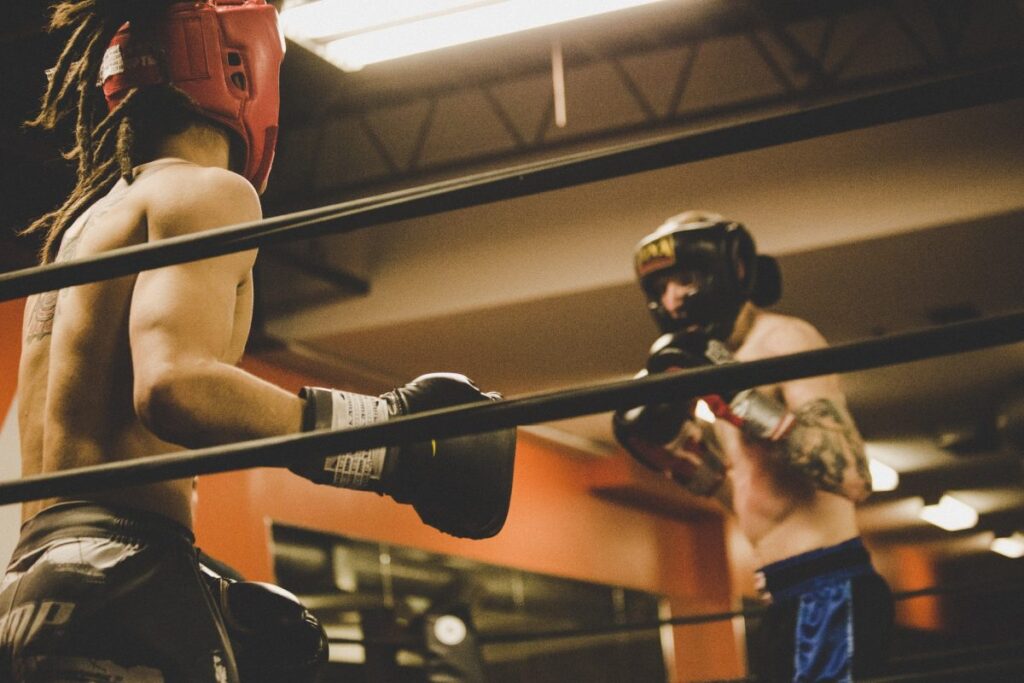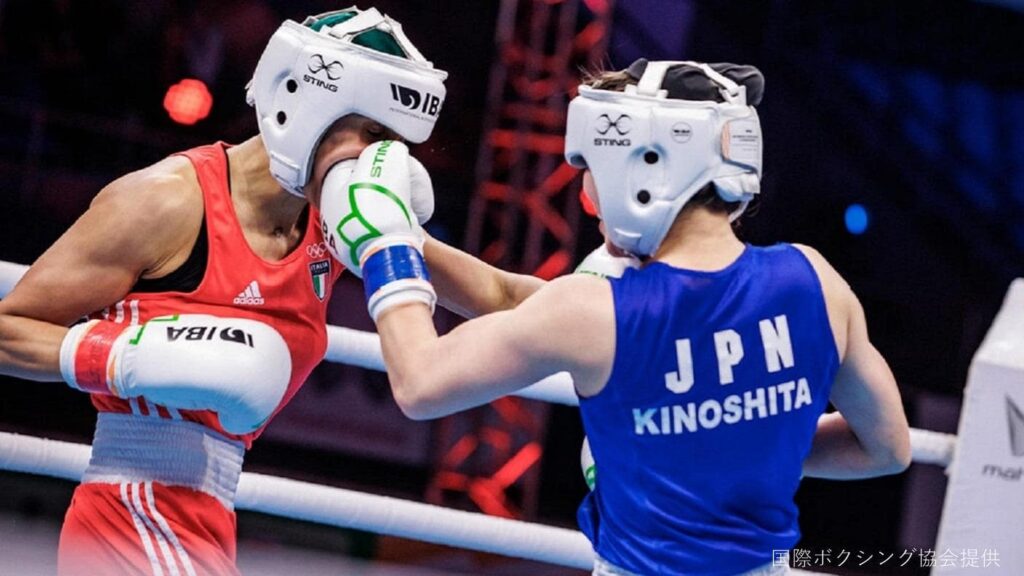
Boxing sparring provides a great opportunity to hone your skills in a way that closely resembles real combat.
In this article, we will explain everything about boxing sparring in detail, including the purpose of sparring, necessary preparations, basic techniques, session construction for advanced players, and application in actual combat.
Through sparring, we aim to provide a way for students to learn offensive and defensive skills in a practical manner and grow beyond their own limits.
We hope that the knowledge and techniques you gain from this guide will directly translate into improved performance in the ring.
目次
What is boxing sparring?
Boxing sparring is a simulated fight that is carried out as part of training and is as close as possible to a real match.
This practice is aimed at developing technique, experimenting with tactics, and conditioning the body.
Sparring provides a valuable opportunity for athletes to gain practical experience in the ring, contributing not only to technical skills but also to mental strength.
Purpose and basic rules of sparring
The main purpose of sparring is to hone your technique and increase your reaction speed under the pressure of a real boxing match.
It is also done to develop the ability to read the opponent’s movements and improve the balance between attack and defense.
The basic rules are the same as those for regular boxing matches, but efforts must be made to limit full-contact blows and prioritize the safety of the athletes.
It differs from regular matches in that excessive intensity is avoided and emphasis is placed on learning and practicing techniques.
Preparing for sparring: Necessary equipment and safety measures
Proper equipment is essential for safe sparring.
Essential equipment includes quality boxing gloves, a gum shield, headgear, and appropriate training wear.
Headgear is especially important as it provides adequate head protection and cushions blows.
You can also minimize the risk of injury by warming up and stretching thoroughly before your sparring session.
Coaches and trainers should try to pair players according to their skill level to maximize the learning potential of each player.
Through these preparations and understanding of the rules, sparring becomes one of the most practical and effective training methods for athletes.

Basic sparring techniques
Sparring is an essential training method for honing your boxing skills.
This section will focus on effective jabs and straight shots and basic defensive techniques in sparring.
How to hit an effective jab and straight shot
The jab is one of the basics of boxing, and is used to measure distance from an opponent, create an opening for an attack, or initiate an attack combination.
For an effective jab, plant your feet firmly on the ground, shift your weight lightly onto your front foot, and quickly thrust your arm forward until your forearm is fully extended.
When returning, be quick and always try to return to the guard position.
Straights (especially straights from the rear hand) have the most destructive power among punches.
To effectively throw this punch, rotate your entire body around the toes of your back foot and use that momentum to launch the punch.
Rotation of the hips is the key, and it is important to put the power of your entire body, not just your arms, into the punch.
Defense techniques: basics of blocking and evasion
There are three main defensive techniques in sparring: parrying, blocking, and evading attacks (ducking and weaving).
To effectively block, it is important to cover the area targeted by your opponent’s punch with your hands or arms to disperse the impact of the blow.
Evasion techniques require you to quickly move your body out of the path of your opponent’s punches, which requires good footwork and body flexibility.
By practicing these techniques repeatedly in sparring, you will develop the ability to react calmly and effectively in real-life match situations.
It takes time to master each technique, but your skills will definitely improve with steady practice.

footwork in sparring
In boxing sparring, effective footwork is extremely important for both attack and defense.
This section details the basics of footwork and techniques for its practical application.
Importance of footwork and basic steps
Footwork is the foundation of positioning and movement in boxing.
Good footwork allows you to maintain balance in the ring and launch attacks effectively, while also providing the speed and maneuverability to evade your opponent’s attacks.
Basic footwork includes forward, backward, and lateral movement.
It is important to perform these movements without spreading your legs too wide and always keeping a constant distance from each other.
Additionally, by using the entire sole of your foot to firmly press down on the ground, you can maintain a state of ease of movement at all times.
Footwork application techniques in actual combat
In order to use footwork effectively in sparring and actual combat, you need the ability to quickly change position according to your opponent’s movements.
For example, if your opponent throws a strong punch, it is effective to quickly take a step back to distance yourself or use a side step to move sideways and get out of the line of attack.
Also, when using it offensively, it’s important to use short, quick steps to get closer to your opponent and shorten the distance your punches can reach.
Another tactic is to use footwork to change the rhythm.
Moving erratically makes it difficult for your opponent to predict your movements.
This technique is especially effective against experienced opponents and can derail their plans.
To learn effective footwork, it is recommended to start with basic steps and gradually incorporate more complex movements and tactical applications into your training.
The goal is to improve your physical strength and reaction speed through regular practice so that you can use your footwork with confidence in sparring and actual combat.

Building a sparring session
Sparring is an important training method to practically hone your boxing skills.
How you structure your session will vary depending on the experience level of your participants.
This section details how to plan a sparring session for beginners and experts.
Planning a sparring session for beginners
Sparring sessions for beginners should focus on understanding basic techniques and safe practice. It is recommended that sessions be constructed as follows:
- Warm up and stretch : Start with a proper warm up and stretch to activate all your body’s muscles and prevent injury.
- Review of basic techniques : Review basic punching techniques such as jabs, straights, and hooks, as well as basic defensive techniques.
- Light sparring : Beginners engage in light-touch sparring to learn real-world movements and reactions. At this stage, focus more on defense and maintaining correct form than attack.
- Feedback and Adjustments : Adjust technique and form based on feedback from trainers and coaches.
High-intensity training plan for advanced athletes
Our advanced sparring sessions aim to improve your technical and physical strength for competition level. The following is a general plan:
- Dynamic Warm-up : Prepare your body for high-intensity activity with a dynamic warm-up.
- Tactical Skill Work : Practice specific tactics and combinations and practice them in sparring.
- Full-Intensity Sparring : Test your reaction time, endurance, and tactical adaptability with full-intensity sparring, which mimics actual combat.
- Detailed review and analysis : Evaluate performance and identify areas for improvement using video analytics.
These sessions contribute not only to technical growth but also to mental strength, preparing boxers to perform at their best in the ring.

Common mistakes and countermeasures in sparring
Sparring is an effective way to improve your boxing skills, but there are some common mistakes that many boxers, from beginners to advanced boxers, make.
This section details common sparring mistakes, how to correct them, and effective recovery techniques.
Common mistakes and how to fix them
-
Excessive strain : Excessive strain during sparring slows down your movements and wastes energy. Relaxing your punches allows you to strike faster and more accurately. Practice taking deep breaths and relaxing your shoulders and arms.
-
Looking down : When you receive a blow, you tend to reflexively look down, but this can cause you to miss the next attack. Always follow your opponent’s movements with your eyes and remember to keep your head up.
-
Weak cover : You may be too focused on attacking and your guard may become lax. Always be aware of your own protection and practice keeping your hands around your face.
effective recovery techniques
-
Readjust your positioning : After taking a hit, it’s important to immediately correct your positioning and reestablish the appropriate distance. Use your footwork to maintain a safe distance and prepare to attack.
-
Breathing control : When stress and fatigue increase, breathing tends to become shallow and rapid. Control your heart rate and regain a relaxed state by breathing deeply and slowly.
-
Use the clinch : When you receive damage, use a temporary clinch (holding your opponent) to buy time for recovery. This gives you time to escape the punch.
By incorporating these techniques into your practice, you can significantly improve your sparring performance.
Recognizing mistakes and correcting them is a shortcut to improving your skills.

Tactical training using sparring
Sparring is an essential training method for improving boxing skills, and is particularly effective in honing tactical abilities.
By practicing both offensive and defensive tactics, you can greatly improve your performance in matches.
Below, we will explain in detail how to practice offensive tactics using sparring and techniques to improve defensive tactics.
How to practice attack tactics
When practicing attack tactics during sparring, it is important to set up a realistic scenario. Let’s try the following methods:
- Practice combinations : Plan out specific punch combinations in advance and use them consciously during sparring. This will help you understand which combinations work in which situations.
- Distance Management : Practice using aggressive footwork to maintain ideal striking distance. The ability to attack while maintaining an appropriate distance from your opponent is directly linked to success in the match.
- Practice timing : Practice launching your attack at the moment your opponent finishes his attack or at the moment your opponent goes on the defensive. This will develop your ability to exploit your opponent’s gaps.
Techniques to improve defensive tactics
You can also effectively improve your defensive techniques through sparring. Try these techniques:
- Counter Attack : Practice countering quickly after blocking or dodging an opponent’s attack. This will help you develop a smooth transition from defense to attack instantly.
- Using the clinch : Learn how to effectively use the clinch while sparring. This is important in order to reduce the momentum of your opponent’s attack and reposition yourself in an advantageous position.
- Avoid with body movements : In addition to directly blocking punches, practice dodging by leaning, ducking, and weaving. This allows you to effectively nullify your opponent’s attacks and increase your counter chances.
By actively practicing these tactics in sparring, boxers will have more options in the ring and will be able to fight with confidence.

Sparring mindset for actual combat
Sparring is important not only for honing boxing techniques, but also for psychological preparation for actual combat.
In this section, we’ll delve into the mental training and pre-match strategies that are important for pre-competition sparring.
Mental training and psychological preparation
Strengthening your mental health through sparring is essential to improving your performance in matches. It is important to be aware of the following points:
- Dealing with pressure : Sparring creates an environment of pressure similar to that of a match. This will help you get used to the tension of a real match and develop your mental strength.
- Staying focused : Practicing staying focused during sparring will help you maintain your performance over longer rounds.
- Developing a positive mindset : Use affirmations (positive words) to increase self-esteem and establish a fighting attitude with confidence in your mind.
Pre-match sparring strategy
The following strategies can be effective in your sparring session before a match:
- Test your match plan : Use sparring to test your match tactics and see which techniques work. You will also practice countermeasures against your opponent’s tactics.
- Practice Adaptation : Play against different sparring partners and improve your adaptability to different fighting styles. This gives you the flexibility to respond to any type of customer.
- Improving situational judgment : We intentionally create difficult situations during sparring and practice making the best decisions in those situations. This will develop your ability to respond calmly when unexpected situations occur during a match.
Sparring is a very effective tool for not only technical preparation but also mental preparation.
By practicing these mindsets and strategies before a match, you’ll be confident and ready to perform at your best in the ring.
summary
This article has provided extensive information about boxing sparring, including its purpose, basic techniques, tactical applications, and mindset.
Sparring is an important training method for practically honing boxing skills, supporting the growth of athletes in all aspects, from attack to defense, footwork, and even psychological preparation.
Beginner sparring sessions focus on reviewing basic techniques and safe practice, while advanced sessions focus on high-intensity training and tactical practice.
To prepare for the actual battle, sparring requires you to handle pressure, maintain concentration, and develop a positive mindset.
As this guide will show you, sparring is more than just practice.
It is a process of comprehensively training technique, tactics, and mentality, and is an essential element for boxers to perform at their best in the ring.
Proper sparring practice offers boxers of all levels the chance to take their skills and confidence to the next level.



